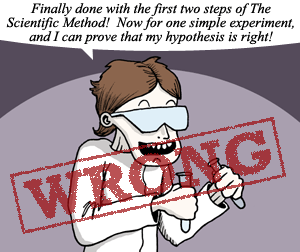
The stereotypical image of a scientist is not a very social one: a geeky guy, isolated in a windowless basement lab, strictly following the rules of THE Scientific Method, until he finally makes a great discovery. No collaborators, no communication, no diversity. What's wrong with this picture? Well, several things:
- First, as discussed in How science works, there is no single scientific method that can be blindly followed. The process of science is flexible and may take many possible paths.
- Second, science is done by unique individuals — not by automated robots coldly following a routine without motivation, ambition, or creativity. Scientists are people too! Many of them care passionately about their work, and many of them are intensely creative. Their personalities, backgrounds, and goals are highly diverse.
- And finally, science is embedded within a global scientific community. This community provides cultural norms, expectations, and accumulated knowledge, which are essential to the expansion of scientific knowledge.
In opposition to its stereotype, science much more typically works something like this: After reading up on the recent work of other scientists studying animal behavior, a scientist in Brazil gets an idea for a new bird song experiment while playing a word game with her kids. She calls a colleague in Canada to discuss the idea and to find out where she can get the recording software she will need for the experiment. She then recruits a few students and a visiting researcher from China to work on the project, and they apply for funding. After they complete the study, the team writes up the work and submits it to a journal for publication. The journal sends it out to three different scientists for review: one in Japan, one in the U.S., and one in the U.K. The reviewers like the study but suggest some changes to improve the statistical analysis. The team makes the changes and the paper is published several months later. A graduate student in France reads the paper with his lab group, emails the Brazilian researcher to learn more about her experimental procedures, and comes up with a follow-up experiment. He recruits another graduate student and a professor to work on the project with him … and so on. Compared to its stereotype, real science is more complex — but also more human.
Scientists do spend time working alone — in the field, in the lab, or at the computer — but most also collaborate on research with others. And, of course, scientists don't just do research. Most scientific work also involves reviewing other scientists' articles for journals, teaching, mentoring graduate students and younger scientists, speaking at conferences, and participating in scientific societies. So the job of being a scientist involves lots more than disappearing into a windowless lab and running an endless series of experiments!
Here we'll discuss how individual scientists interact with the rest of the scientific community and how this benefits the progress of science. You can investigate:
The scientific community: Diversity makes the difference Science: A community enterprise Scientific culture: Great expectations The scientific community and misconduct